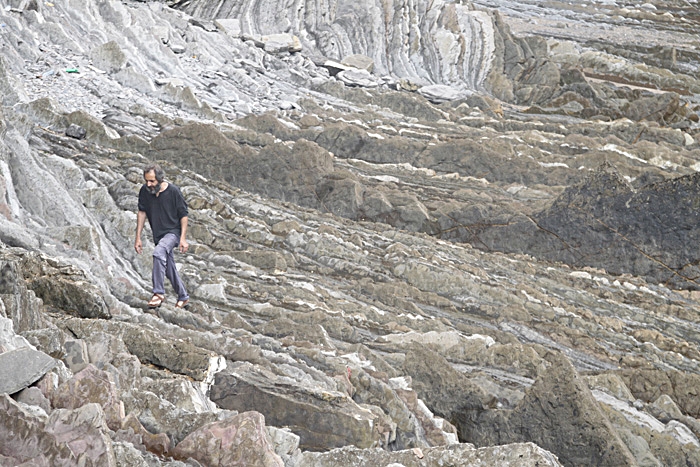
Formado como escultor, Gabriel Díaz (Pamplona, 1968) comienza a trabajar a principios de los noventa siguiendo la poética del Land Art mediante intervenciones realizadas sobre roca, arena, madera o con pedazos de hielo.
El intento de superación de la forma, de penetrar más allá de la materia y conseguir encontrar algo detrás, es una constante en todo su trabajo; ya sea desde el equilibrio, el desafío de las leyes físicas, la anulación del grosor persiguiendo encontrar su inmaterialidad, o desde la noción del pasaje o pasadizo, algo que desemboca en un estudio sobre el lugar y el tránsito.
En sus esculturas e instalaciones, suspende piedras en el aire en las que la mirada penetra hasta su interior, las sostiene sobre inverosímiles soportes o las incrusta en la pared, dibuja su superficie o la extensión del firmamento, nos enfrenta al vacío de las tumbas abiertas o nos arrastra hacia el espacio abismal o telúrico.
Además de la escultura, para la que utiliza diferentes materiales como mármol, alabastro o hierro, sin olvidar el vídrio y el metacrilato, Díaz explora otros soportes artísticos, como la fotografía o el vídeo, filmando sus trabajos en cuevas, grutas, agujeros de hielo o desagües de agua para realizar obras que aúnan la predilección por la naturaleza con las nociones de interior/exterior, entrada/salida o vacío/lleno.
A principios de 2000, viaja por primera vez a Tíbet donde realizará diversos trabajos en vídeo sobre lugares naturales sagrados comenzando así una ardua y extensa serie de obras sobre las peregrinaciones en oriente y occidente.
En la actualidad trabaja en un nuevo proyecto con el que retorna a la escultura en piedra.
After training as a sculptor, Gabriel Díaz (Pamplona, 1968) produced his first work at the start of the nineties. His early pieces appropriated the poetics of Land Art with their interventions in rock or using pieces of ice.
In this sculpture-dominated stage, he was already setting human alongside cosmic values, championing a return to the traditional reciprocity between the arts and the sciences. And it is here that we can locate one of the artist’s distinguishing traits: his desire to merge different knowledge areas, to dialogue with disciplines ranging from aesthetics to physics, geology or Zen wisdom.
This expansiveness has led him to explore different artistic media and to make his first video in 1999. He films in caves, grottos, ice tunnels or drains to create works that wed his love of nature with notions of inside/outside, entrance/exit or emptiness/fullness as a metaphor of the artist’s inner searching.
His quest took him to Tibet. After completed some of the main pilgrim routes in Tibetan culture, he decided to follow the Way of St. James in several of its variants. This was the beginning of his video production using the photo animation technique. He travelled the routes taking a photograph every eleven steps, so the spectator could get a “live” experience of a pilgrimage through the author’s contemporary gaze
Gabriel Díaz has shown at leading galleries and institutions, among them the Museo Nacional Centro de Arte Reina Sofía (MNCARS), the Bilbao Guggenheim, the Galician Centre for Contemporary Art (CGAC) in Santiago de Compostela, Artium in Vitoria, the LABoral in Gijón and the Municipal Museum of Contemporary Art in Madrid/Centro Cultural del Conde Duque. His work can be found in the collections of MNCARS, Fundació La Caixa, Artium, Museo de Arte Contemporáneo de Castilla y León (MUSAC), Fundación Caja de Madrid, CGAC and Fundación AENA, among others.